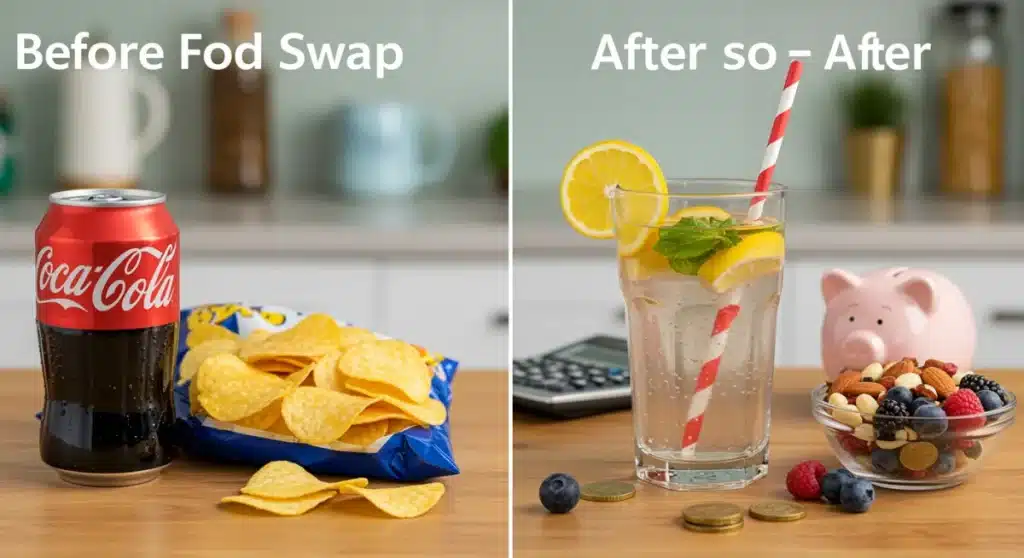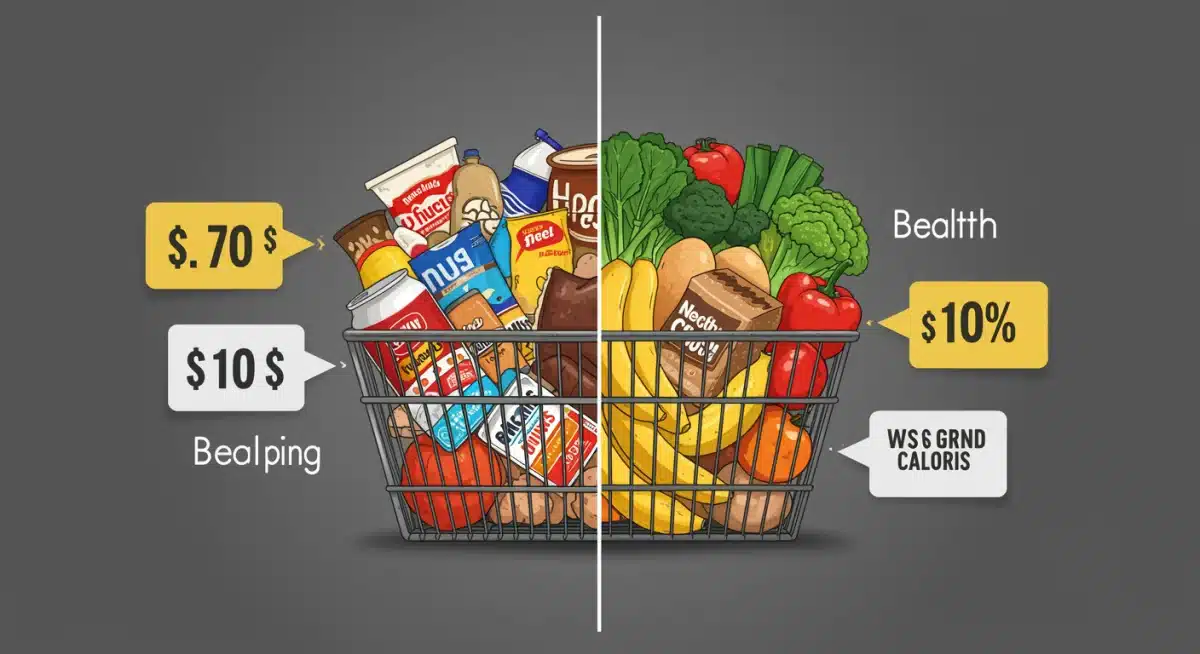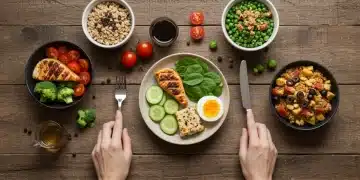Smart Swaps: Cut 200 Calories, Save Money, Boost Health

Implementing simple, consistent dietary adjustments can lead to a daily 200-calorie reduction, significantly impacting long-term health and generating notable financial savings without compromising taste or satisfaction.
Embarking on a journey to better health often feels like an uphill battle, especially when it involves strict diets and sacrificing beloved foods. However, the concept of smart calorie swaps offers a refreshing alternative, proving that small, intentional changes can yield significant health benefits and even positive financial impacts without requiring a complete overhaul of your lifestyle.
the power of small changes: why 200 calories matter
Many people believe that significant weight loss or health improvements demand drastic dietary restrictions. While intense diets can show quick results, they are often unsustainable and can lead to a cycle of deprivation and overeating. The truth is, consistency in small, manageable changes often leads to more profound and lasting success.
Reducing your daily caloric intake by just 200 calories might seem insignificant at first glance. However, over time, these seemingly minor adjustments accumulate, creating a substantial impact on your overall health and weight management goals. This approach is less about deprivation and more about mindful eating, making smarter choices that fit seamlessly into your daily routine.
understanding the cumulative effect
- Weekly Impact: Cutting 200 calories daily amounts to 1,400 calories saved per week.
- Monthly Impact: Over a month, this totals approximately 5,600 calories, which is roughly equivalent to 1.6 pounds of fat.
- Annual Impact: Annually, you could potentially save over 67,200 calories, translating to a significant weight reduction of around 19 pounds.
Beyond weight management, this subtle calorie reduction can improve energy levels, enhance metabolic health, and reduce the risk of chronic diseases. It’s a sustainable path that fosters a healthier relationship with food, allowing you to enjoy your meals while still making progress towards your wellness objectives. The beauty of this method lies in its simplicity and its focus on gradual, achievable goals rather than intimidating, restrictive measures.
In essence, the power of small changes lies in their ability to be integrated effortlessly into daily life, making healthy eating less of a chore and more of a natural habit. By understanding the long-term cumulative effect, you can appreciate how each small swap contributes to a larger, more impactful health transformation, both physically and financially.
breakfast brilliance: starting your day smarter
Breakfast is often hailed as the most important meal of the day, and for good reason. It sets the tone for your energy levels and metabolic activity. Unfortunately, many common breakfast choices are laden with hidden calories, sugars, and unhealthy fats, sabotaging your efforts before the day even truly begins. Making smart swaps at breakfast can be one of the easiest ways to shave off 200 calories without feeling deprived.
Consider the typical American breakfast: a sugary cereal with whole milk, a pastry, or a large flavored coffee. Each of these can easily push you over your calorie goals. By opting for nutrient-dense alternatives, you can fuel your body more effectively, stay fuller longer, and significantly reduce your caloric intake.
cereal and milk makeovers
- Swap Sugary Cereal for Oatmeal: A bowl of sugary cereal can contain upwards of 200 calories from refined grains and added sugar. Opt for plain rolled oats (150 calories per ½ cup dry) cooked with water or unsweetened almond milk.
- Choose Low-Fat or Skim Milk: Switching from whole milk (150 calories per cup) to skim milk (80 calories per cup) saves 70 calories instantly. Even better, unsweetened almond milk has only about 30-40 calories per cup.
- Add Natural Sweeteners: Instead of spoonfuls of sugar, sweeten your oatmeal with a sprinkle of cinnamon, a few berries (30 calories per ¼ cup), or a teaspoon of honey (20 calories).
Another common breakfast trap is the grab-and-go pastry. A typical muffin or croissant can easily pack 300-500 calories. Replacing this with a piece of fruit and a small handful of nuts can save hundreds of calories and provide more sustained energy. For example, a large banana (105 calories) and 10 almonds (70 calories) total 175 calories, a significant reduction from a pastry.
Even your morning coffee can be a calorie culprit. A large flavored latte with whole milk and syrup can quickly add 250-400 calories. Switching to a black coffee (5 calories) or an americano (15 calories) with a splash of skim milk (10 calories) can save you a substantial amount of calories daily. These small shifts at the start of your day create a ripple effect, making it easier to maintain healthy eating habits throughout the day.
lunchtime liberation: healthy and satisfying midday meals
Lunch can be another minefield of hidden calories, especially for those who eat out frequently or rely on convenience foods. A seemingly innocent sandwich, salad, or fast-food option can easily exceed your calorie goals for the entire day. The key to lunchtime liberation is to focus on whole, unprocessed ingredients that provide satiety and essential nutrients without the excess calories.
Many lunchtime staples, such as creamy dressings, fried sides, and oversized portions, contribute significantly to caloric overload. By making conscious choices and preparing meals in advance, you can dramatically reduce calorie intake and often save money in the process. This approach helps maintain energy levels and avoids the post-lunch slump often associated with heavy, unhealthy meals.
sandwich and salad secrets
- Lighter Bread Choices: Instead of thick white bread (150-200 calories per two slices), opt for thin-sliced whole wheat bread (80-100 calories per two slices) or lettuce wraps (5-10 calories). This simple swap can save 70-120 calories.
- Leaner Protein: Replace processed deli meats (e.g., bologna, salami, 100-150 calories per serving) with lean grilled chicken breast, turkey, or chickpeas (50-80 calories per serving).
- Mindful Condiments: Mayonnaise (100 calories per tablespoon) and creamy dressings (100-150 calories per two tablespoons) are calorie bombs. Switch to mustard (0-5 calories), vinegar-based dressings (30-50 calories), or a squeeze of lemon juice.
When it comes to salads, the term "healthy" can be misleading. A salad loaded with fried chicken, bacon, croutons, and creamy dressing can easily surpass the calorie count of a burger. To make your salad truly healthy, focus on a base of dark leafy greens, plenty of non-starchy vegetables, a lean protein source, and a light dressing. For example, swapping a fried chicken salad (600-800 calories) for a grilled chicken and veggie salad with vinaigrette (350-450 calories) can save 250-450 calories.

Another excellent strategy is meal prepping your lunches. Preparing your meals at home gives you complete control over ingredients and portion sizes. This not only ensures healthier options but also significantly reduces the temptation to buy expensive, calorie-dense takeout. A homemade turkey and veggie wrap, for instance, is far more nutritious and cost-effective than a fast-food combo meal, saving both calories and dollars.
dinner dilemmas: making evening meals lighter
Dinner is often the largest meal of the day, and it can be challenging to reduce calories without feeling hungry afterward. However, with a few strategic adjustments, you can enjoy satisfying evening meals that support your calorie goals. The focus should be on nutrient density, portion control, and healthier cooking methods.
Common dinner pitfalls include oversized portions of pasta, rich sauces, fried foods, and excessive amounts of cheese. These elements can quickly add hundreds of extra calories, making it difficult to maintain a calorie deficit. By prioritizing vegetables, lean proteins, and whole grains, you can create balanced and flavorful dinners that are both light and fulfilling.
cooking method and ingredient adjustments
- Grilling or Baking vs. Frying: Frying foods in oil can add hundreds of calories. For example, a fried chicken breast can have 350-400 calories, while a grilled one has around 200-250 calories, saving 100-200 calories per serving.
- Swap White Pasta for Veggie Noodles: A cup of cooked white pasta contains about 200 calories. Replace half or all of it with spiralized zucchini or spaghetti squash (30-40 calories per cup) for a substantial calorie reduction.
- Leaner Protein Choices: Opt for lean cuts of meat like chicken breast, fish, or tofu instead of fatty cuts or processed meats. For example, swapping a fatty steak (500-600 calories) for baked salmon (300-350 calories) can save 150-300 calories.
Portion control is another critical aspect of making dinners lighter. Many restaurant portions are double or triple what a single serving should be. At home, use smaller plates and measure your ingredients to ensure you are consuming appropriate amounts. Adding a large serving of non-starchy vegetables to your plate can help fill you up without significantly increasing calories.
For instance, instead of a large bowl of creamy pasta with garlic bread, opt for a smaller portion of whole-wheat pasta with a tomato-based sauce, loaded with vegetables, and a side salad. This shift can easily cut 200-300 calories while still providing a delicious and satisfying meal. Thinking creatively about ingredients and preparation methods allows for enjoyable dinners that align with your health objectives.
snack savvy: smart choices between meals
Snacks can be a double-edged sword: they can either keep your energy levels stable and prevent overeating at main meals, or they can be significant sources of empty calories that derail your dietary goals. Many popular snack foods, such as chips, cookies, and candy bars, are high in sugar, unhealthy fats, and calories, offering little nutritional value. Making smart snack choices is crucial for maintaining a calorie deficit and supporting overall health.
The key to successful snacking is planning. Having healthy options readily available can prevent you from reaching for less nutritious, high-calorie alternatives when hunger strikes. Focus on snacks that are rich in fiber and protein, as these nutrients promote satiety and provide sustained energy.
common snack pitfalls and solutions
- Chips vs. Veggies and Hummus: A small bag of potato chips (150-200 calories) can be easily replaced with a serving of carrots and hummus (70-100 calories). This swap saves 50-130 calories and provides fiber and protein.
- Candy Bar vs. Fruit and Nuts: A standard chocolate bar (250-300 calories) offers little nutritional benefit. Instead, choose an apple (95 calories) with a small handful of almonds (70 calories), totaling 165 calories, saving 85-135 calories.
- Sugary Yogurt vs. Plain Greek Yogurt: Flavored yogurts can contain upwards of 150-200 calories and significant added sugar. Plain Greek yogurt (100 calories per cup) with a few berries (30 calories) is a protein-packed alternative, saving 20-70 calories.
Hydration also plays a significant role in managing hunger and calorie intake. Often, thirst is mistaken for hunger, leading to unnecessary snacking. Drinking a glass of water before reaching for a snack can help determine if you are truly hungry. Additionally, opting for unsweetened beverages instead of sugary sodas or juices can save hundreds of calories throughout the day.
Preparing your snacks in advance, similar to meal prepping, can be incredibly effective. Portioning out nuts, fruits, or veggie sticks into individual containers makes them convenient and prevents overconsumption. By being mindful of your snack choices, you can effectively manage hunger, boost nutrient intake, and consistently cut down on those extra 200 calories daily.
beverage makeovers: sipping your way to savings
Beverages are often overlooked contributors to daily calorie intake, yet they can be significant sources of hidden sugars and empty calories. From sugary sodas and sweetened teas to elaborate coffee drinks and alcoholic beverages, what you drink can easily add hundreds of calories without providing any real satiety. Making smart beverage swaps is one of the quickest and most effortless ways to cut 200 calories daily.
Many people consume their daily calorie allowance through drinks without even realizing it. These liquid calories don’t typically register as "food" in the same way solid meals do, making it easy to overconsume. Focusing on water and unsweetened options can drastically reduce your caloric intake and offer numerous health benefits.
liquid calorie culprits and healthier alternatives
- Sugary Sodas and Juices: A 12-ounce can of soda contains about 140-150 calories and 35-40 grams of sugar. Fruit juices, even 100% juice, can be similarly high in calories due to natural sugars. Swapping for water or unsweetened iced tea saves 140-150 calories.
- Sweetened Coffee Drinks: A large flavored latte or frappuccino can range from 250-400 calories. Opting for black coffee (5 calories), unsweetened tea (0 calories), or an americano with a splash of skim milk (15-20 calories) can save 200-380 calories.
- Alcoholic Beverages: A single beer (150-200 calories) or a cocktail (150-300+ calories, depending on mixers) can quickly add up. Choosing sparkling water with a squeeze of lime, or limiting alcoholic drinks and alternating with water, can significantly reduce liquid calories.
Water is your best friend when it comes to calorie reduction. It contains zero calories, keeps you hydrated, and can help you feel fuller, potentially reducing overall food intake. If plain water feels too bland, try infusing it with fruits like lemon, cucumber, mint, or berries for a refreshing, flavorful, and calorie-free alternative. This not only enhances taste but also encourages greater water consumption.

Beyond calorie savings, reducing your intake of sugary beverages also has profound health benefits, including better dental health, reduced risk of type 2 diabetes, and improved cardiovascular health. By consciously choosing healthier sips, you contribute substantially to your daily 200-calorie reduction goal and foster a more vibrant, healthier lifestyle.
financial impact: saving money with smart food choices
The beauty of implementing smart calorie swaps extends far beyond just health benefits; it also translates into significant financial savings. Many high-calorie, processed foods and sugary drinks are more expensive than their healthier, whole-food counterparts. By opting for fresh, unprocessed ingredients and preparing meals at home, you can trim your grocery bill and reduce expenses related to dining out.
This financial synergy makes the adoption of healthier eating habits even more appealing. When you prioritize whole foods, you often find that your money goes further, allowing you to invest in higher-quality ingredients or save for other financial goals. The shift from convenience to conscious consumption is a win-win for both your wallet and your waistline.
cost-effective healthy eating strategies
- Home Cooking vs. Eating Out: A single restaurant meal can easily cost $15-$30 and often contains excessive calories and unhealthy fats. Preparing a similar meal at home almost always costs significantly less, often under $5-$10 per serving, and allows for calorie control.
- Bulk Buying Staples: Purchasing staples like oats, beans, lentils, and whole grains in bulk is much cheaper per serving than buying individual processed snack packs or refined grain products.
- Seasonal Produce: Buying fruits and vegetables that are in season is not only fresher and more flavorful but also considerably less expensive. For example, berries in summer are far more affordable than in winter.
Consider the cumulative financial impact of daily small swaps. Replacing a daily $5 flavored coffee with a homemade black coffee that costs pennies can save you over $1,800 annually. Swapping a $10 fast-food lunch for a homemade meal costing $3 saves $7 daily, totaling over $2,500 per year. These individual savings quickly add up, demonstrating how healthy eating can directly bolster your financial well-being.
Furthermore, investing in your health through better nutrition can reduce future healthcare costs. A diet rich in whole foods and low in processed items can decrease the risk of chronic diseases, leading to fewer doctor visits, medications, and health complications down the line. Thus, these smart swaps are not just about immediate savings but also about long-term financial prudence, securing both your health and your economic future.
overcoming challenges and sustaining the change
Adopting any new habit comes with its challenges, and making smart food swaps is no exception. While the concept is simple, execution requires consistency, planning, and a degree of self-awareness. Common hurdles include cravings, social pressures, time constraints, and the sheer abundance of tempting, unhealthy options. However, with the right strategies, these challenges can be effectively overcome, leading to sustainable lifestyle changes.
The key to long-term success lies in building a supportive environment, both physically and mentally. This means stocking your pantry with healthy options, learning to say no to unhealthy temptations, and finding joy in the process of preparing nutritious meals. Sustainability comes from integrating these changes seamlessly into your life rather than viewing them as temporary restrictions.
strategies for lasting change
- Meal Planning and Preparation: Dedicate time each week to plan your meals and snacks. This reduces impulsive, unhealthy choices and ensures you have nutritious options readily available. Prepping ingredients like chopped vegetables or cooked grains saves time during busy weekdays.
- Mindful Eating: Pay attention to your body’s hunger and fullness cues. Eat slowly, savor your food, and avoid distractions like screens. This helps you recognize when you’re truly satisfied and prevents overeating.
- Building a Support System: Share your goals with friends or family who can offer encouragement. Consider cooking with a partner or joining a community that promotes healthy eating habits.
Addressing cravings is another crucial aspect. Instead of completely denying yourself, try to find healthier alternatives that satisfy similar desires. For example, if you crave something sweet, opt for a piece of fruit or a small square of dark chocolate instead of a large dessert. If you crave salty, crunchy snacks, try air-popped popcorn or roasted chickpeas.
Remember that perfection is not the goal; consistency is. There will be days when you deviate from your plan, and that’s perfectly normal. The important thing is to get back on track with your next meal or snack, without guilt or self-reproach. By focusing on progress, not perfection, and continually learning what works best for your body and lifestyle, you can make these smart calorie swaps a sustainable part of your journey towards better health and financial well-being.
| Key Swap Category | Brief Description of Savings |
|---|---|
| Breakfast Choices | Switching from sugary cereals/pastries to oatmeal with fruit and lean milk saves 70-200+ calories and reduces daily spending. |
| Lunch & Dinner Meals | Opting for homemade, grilled lean proteins, vegetable-heavy meals, and light dressings instead of fried foods and creamy sauces saves 100-300+ calories and significantly cuts restaurant costs. |
| Snacks & Beverages | Replacing chips/candy with fruit/nuts, and sugary drinks with water/unsweetened tea, saves 50-200+ calories per item and reduces impulse purchases. |
| Overall Financial Impact | Consistent smart swaps can lead to annual savings of hundreds to thousands of dollars by reducing reliance on processed foods, takeout, and sugary drinks. |
frequently asked questions about smart calorie swaps
While individual results vary, consistently cutting 200 calories daily can lead to a weight loss of approximately 1.5 to 2 pounds per month, totaling around 19-24 pounds annually. This gradual approach promotes sustainable weight management and overall health improvement, making it a highly effective long-term strategy.
Absolutely. Many high-calorie items like sugary drinks, processed snacks, and restaurant meals are often more expensive than their healthier, homemade alternatives. By choosing water over soda or cooking at home instead of dining out, you can save significant amounts of money daily, weekly, and annually, impacting your budget positively.
Not necessarily. The focus of smart swaps is on replacing calorie-dense, nutrient-poor foods with nutrient-rich, satisfying alternatives. By choosing foods high in fiber and protein, you can feel fuller for longer, preventing hunger and deprivation. The goal is sustainable changes, not restrictive dieting.
Yes, the strategy is about moderation and smarter choices, not complete elimination. You can still enjoy favorite foods by adjusting portion sizes, opting for healthier cooking methods, or making small ingredient substitutions. For instance, a smaller slice of pizza with a large side salad is a great compromise.
There are numerous free apps and online tools that can help you track your calorie intake. Log your food for a few days to identify where your calories are coming from and pinpoint easy opportunities for swaps. This awareness is key to making informed decisions and achieving your 200-calorie reduction goal effectively.
conclusion
Embracing smart calorie swaps is a powerful, sustainable strategy for enhancing both your health and financial well-being. By consistently making small, intentional adjustments to your daily food and beverage choices, you can effortlessly cut 200 calories, leading to significant weight management benefits, improved energy, and reduced risk of chronic diseases. More than just a dietary tactic, this approach empowers you to make mindful decisions that positively impact your budget, proving that healthy living doesn’t have to be expensive or restrictive. It’s about cultivating a healthier relationship with food, one delicious and sensible swap at a time, paving the way for a more vibrant and financially secure future.





